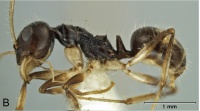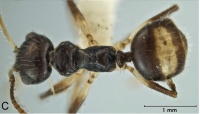Teratomyrmex substrictus
| Teratomyrmex substrictus | |
|---|---|

| |
| Scientific classification | |
| Kingdom: | Animalia |
| Phylum: | Arthropoda |
| Class: | Insecta |
| Order: | Hymenoptera |
| Family: | Formicidae |
| Subfamily: | Formicinae |
| Tribe: | Melophorini |
| Genus: | Teratomyrmex |
| Species: | T. substrictus |
| Binomial name | |
| Teratomyrmex substrictus Shattuck & O'Reilly, 2013 | |
This species is known from a limited number of locations in Far North Queensland just north and south of Cairns. All collections are from rainforest and workers were encountered while collecting from low vegetation either by using pyrethrum knockdown or by sweeping vegetation.
Identification
Head and mesosoma dark brown, gaster slightly paler; coxae, trochanters and basal first third of femora white, remainder of femora brown; petiole uniform brown, apex similar in colour to remainder. Pronotum with small and angular humeral angles, lacking large wing-like structures. Body with long, erect hairs only, shorter hairs and pubescence absent. Dorsum of head, pronotum and mesonotum essentially smooth, sculpturing at most only weakly developed. This species is similar to Teratomyrmex tinae but differs in pilosity, sculpturing and colour as outlined above.
Keys including this Species
Distribution
Far north Queensland, just north and south of Cairns.
Latitudinal Distribution Pattern
Latitudinal Range: -17.26666667° to -17.26666667°.
| North Temperate |
North Subtropical |
Tropical | South Subtropical |
South Temperate |
- Source: AntMaps
Distribution based on Regional Taxon Lists
Australasian Region: Australia (type locality).
Distribution based on AntMaps
Distribution based on AntWeb specimens
Check data from AntWeb
Countries Occupied
| Number of countries occupied by this species based on AntWiki Regional Taxon Lists. In general, fewer countries occupied indicates a narrower range, while more countries indicates a more widespread species. |

|
Estimated Abundance
| Relative abundance based on number of AntMaps records per species (this species within the purple bar). Fewer records (to the left) indicates a less abundant/encountered species while more records (to the right) indicates more abundant/encountered species. |

|
Biology
Castes
Known only from the worker caste.
Nomenclature
The following information is derived from Barry Bolton's Online Catalogue of the Ants of the World.
- substrictus. Teratomyrmex substrictus Shattuck & O'Reilly, 2013: 297, fig. 7 (w.) AUSTRALIA.
Type Material
- Holotype, worker, Cableway Base Station, Bellenden Ker Range, Queensland, 100m, Australia, 17°16′S 145°55′E / 17.267°S 145.917°E, 17–24 October 1981, Earthwatch, Qld Museum, ANIC32-066622, Australian National Insect Collection.
- Paratype, 1 worker, Cableway Base Station, Bellenden Ker Range, Queensland, 100m, Australia, 17°16′S 145°55′E / 17.267°S 145.917°E, 17–24 October 1981, Earthwatch, Qld Museum, ANIC32-066622, Australian National Insect Collection.
Unless otherwise noted the text for the remainder of this section is reported from the publication that includes the original description.
Description
Worker
(n=6)—CI 100–106; HL 0.85–1.06 mm; HW 0.85–1.12 mm; ML 1.14–1.44 mm; MTL 0.83–0.97 mm; PronW 0.55–0.73; SI 110–124; SL 1.04–1.24 mm.
Head and mesosoma dark brown, gaster slightly paler. Coxae, trochanters white. Tibiae basally white, changing to light brown at one third length. Petiole light brown. Scattered long setae on head, antennae, gaster, tibiae, tarsi and dorsal side of mesosoma. Pubescence reduced to a few scattered hairs. Head roughly square, concave on the sides and widest at eyes. Mandibles triangular, paler in colour than the head but with dark teeth. Mandibles with six teeth, the first, second and fourth the largest. Clypeus semicircular, with rounded posterior margin, straight anterior margin. Frontal area smooth. Frontal carinae very small, only slightly extending past antennal socket. Eyes large, convex, positioned one third from posterior margin of head, one and a half times longer than wide. Ocelli very small but distinct. Scapes extending one third their length beyond posterior margin of head, paler in colour than head. Mesosoma mostly smooth, with broad longitudinal striations on the side of the mesonotum and propodeum. Dorsal surface of pronotum and mesonotum essentially smooth. In dorsal view pronotum roughly hexagonal, wider than propodeum, with sides tapering slightly laterally with points at the pronotal humeri. Promesonotal suture weakly differentiated from surrounding surfaces. In dorsal view mesonotum roughly oval, the anterior margin weakly convex and the posterior margin strongly convex. Propodeum roughly square in dorsal view, with small spines on upper margin. Petiole much taller than long, weakly convex on dorsal surface. Gaster rectangular, first two segments (abdominal segments III & IV) the largest. Legs slender, tibiae and femora somewhat spindle shaped.
References
References based on Global Ant Biodiversity Informatics
- Shattuck S. O., and A. J. O'Reilly. 2013. Revision of the Australian endemic ant genera Pseudonotoncus and Teratomyrmex (Hymenoptera: Formicidae: Formicinae). Zootaxa 3669 (3): 287301.

